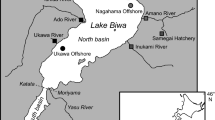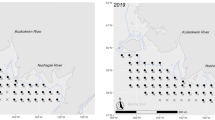Abstract
We examined differences in otolith oxygen (δ18Ootolith) and carbon (δ13Cotolith) stable isotope ratios between hatchery and wild pink salmon fry. The δ18Ootolith values of hatchery and wild fry were −7.7 ± 0.2 ‰ and −8.3 ± 0.3 ‰ (1σ), respectively. This difference reflected differences in temperature conditions experienced by each fry. The δ13Cotolith values of hatchery and wild fry were −19.2 ± 0.3 ‰ and −11.1 ± 1.8 ‰ (1σ), respectively. The lower δ13Cotolith values of hatchery fry were probably related to their intake of artificial diets. Discriminant analysis of δ18Ootolith and δ13Cotolith values demonstrated a highly significant difference between hatchery and wild fry with 95.8 % classification accuracy. Therefore, analysis of δ18Ootolith and δ13Cotolith precipitated in the fry stage may be useful for discriminating the origin of returning adult pink salmon. The discrimination method for returning adult fish would provide important information for evaluating the effect of hatchery release and their impact on the wild population.







Similar content being viewed by others
References
Heard WR (1991) Life history of pink salmon (Oncorhynchus gorbuscha). In: Groot C, Margolis L (eds) Pacific salmon life histories. University of British Columbia Press, Vancouver, pp 119–230
Morita K, Morita SH, Fukuwaka M (2006) Population dynamics of Japanese pink salmon (O. gorbuscha): are recent increases explained by hatchery programs or climatic variations? Can J Fish Aquat Sci 63:55–62
Quinn TP (1993) A review of homing and straying of wild and hatchery-produced salmon. Fish Res 18:29–44
Campana SE (1999) Chemistry and composition of fish otoliths: pathways, mechanisms and applications. Mar Ecol Prog Ser 188:263–297
Campana SE, Thorrold SR (2001) Otoliths, increments, and elements: keys to a comprehensive understanding of fish populations? Can J Fish Aquat Sci 58:30–38
Kalish JM (1991) 13C and 18O isotopic disequilibria in fish otoliths: metabolic and kinetic effects. Mar Ecol Prog Ser 75:191–203
Kalish JM (1991) Oxygen and carbon stable isotopes in the otoliths of wild and laboratory-reared Australian salmon (Arripis-trutta). Mar Biol 110:37–47
Solomon CT, Weber PK, Cech JJ Jr, Ingram BL, Conrad ME, Machavaram MV, Pogodina AR, Franklin RL (2006) Experimental determination of the sources of otolith carbon and associated isotopic fractionation. Can J Fish Aquat Sci 63:79–89
Tohse H, Mugiya Y (2008) Sources of otolith carbonate: experimental determination of carbon incorporation rates from water and metabolic CO2, and their diel variations. Aqua Biol 1:259–268
Nonogaki H, Nelson JA, Patterson WP (2007) Dietary histories of herbivorous loricariid catfishes: evidence from δ13C values of otoliths. Environ Biol Fish 78:13–21
Schwarcz HP, Gao Y, Campana S, Browne D, Knyf M, Brand U (1998) Stable carbon isotope variations in otoliths of Atlantic cod (Gadus morhua). Can J Fish Aquat Sci 55:1798–1806
Dufour E, Patterson WP, Höök TO, Rutherford ES (2005) Early life history of Lake Michigan alewives (Alosa pseudoharengus) inferred from intra-otolith stable isotope ratios. Can J Fish Aquat Sci 62:2362–2370
Schaner T, Patterson WP, Lantry BF, O’Gorman R (2007) Distinguishing wild vs. stocked lake trout (Salvelinus namaycush) in Lake Ontario: evidence from carbon and oxygen stable isotope values of otoliths. J Great Lakes Res 33:912–916
Asami R, Yamada T, Iryu Y, Meyer CP, Quinn TM, Paulay G (2004) Carbon and oxygen isotopic composition of a Guam coral and their relationships to environmental variables in the western Pacific. Palaeogeogr Palaeoclimatol Palaeoecol 212:1–22
Sharma T, Clayton RN (1965) Measurement of O18/O16 ratios of total oxygen of carbonates. Geochim Cosmochim Acta 29:1347–1353
Friedman I, O’Neil JR (1977) Compilation of stable isotope fractionation factors of geochemical interest. US Geol Surv Prof Pap 440:KK1–KK9
Yoshida N, Mizutani Y (1986) Preparation of carbon-dioxide for Oxygen-18 determination of water by use of a plastic syringe. Anal Chem 58:1273–1275
Høie H, Otterlei E, Folkvord A (2004) Temperature-dependent fractionation of stable oxygen isotopes in otoliths of juvenile cod (Gadus morhua L.). J Mar Sci 61:243–251
Deniro MJ, Epstein S (1978) Influence of diet on distribution of carbon isotopes in animals. Geochim Cosmochim Acta 42:495–506
Dufour E, Gerdeaux D, Wurster CM (2007) Whitefish (Coregonus lavaretus) respiration rate governs intra-otolith variation of δ13C values in Lake Annecy. Can J Fish Aquat Sci 64:1736–1746
Sohn D, Kang S, Kim S (2005) Stock identification of chum salmon (Oncorhynchus keta) using trace elements in otoliths. J Oceanogr 61:305–312
Coghlan SM Jr, Lyerly MS, Bly TR, Williams JS, Bowman D, Hannigan R (2007) Otolith chemistry discriminates among hatchery-reared and tributary-spawned salmonines in a tailwater system. N Am J Fish Manage 27:531–541
Kennedy BP, Blum JD, Folt CL, Nislow KH (2000) Using natural strontium isotopic signatures as fish markers: methodology and application. Can J Fish Aquat Sci 57:2280–2292
Sano Y, Shirai K, Takahata N, Amakawa H, Otake T (2008) Ion microprobe Sr isotope analysis of carbonates with about 5 μm spatial resolution: an example from an ayu otolith. Appl Geochem 23:2406–2413
Gao Y (1999) Micro-sampling of fish otoliths: a comparison between DM 2800 and Dremel in stable isotope analysis. Environ Biol Fish 55:443–448
Rollion-Bard C, Mangin D, Champenois M (2007) Development and application of oxygen and carbon isotopic measurements of biogenic carbonates by ion microprobe. Geostand Geoanal Res 31:39–50
Weidel BC, Ushikubo T, Carpenter SR, Kita NT, Cole JJ, Kitchell JF, Pace ML, Valley JW (2007) Diary of a bluegill (Lepomis macrochirus): daily δ13C and δ18O records in otoliths by ion microprobe. Can J Fish Aquat Sci 64:1641–1645
Gao YW, Beamish RJ (1999) Isotopic composition of otoliths as a chemical tracer in population identification of sockeye salmon (Oncorhynchus nerka). Can J Fish Aquat Sci 56:2062–2068
Acknowledgments
We thank Dr. Michael J. Miller of the Ocean Research Institute, the University of Tokyo, for critically reading the manuscript and the staff of Hokkaido National Fisheries Research Institute for providing samples of pink salmon fry. This study was supported by a Sasakawa Scientific Research Grant from the Japan Science Society to Y.T. and Grant-in-Aid for Scientific Research (B) from the Japanese Society for the Promotion of Science (JSPS) to T.O. (No. 17380113, No. 21380122, No. 24380105).
Author information
Authors and Affiliations
Corresponding author
Rights and permissions
About this article
Cite this article
Tomida, Y., Suzuki, T., Yamada, T. et al. Differences in oxygen and carbon stable isotope ratios between hatchery and wild pink salmon fry. Fish Sci 80, 273–280 (2014). https://doi.org/10.1007/s12562-014-0699-9
Received:
Accepted:
Published:
Issue Date:
DOI: https://doi.org/10.1007/s12562-014-0699-9




